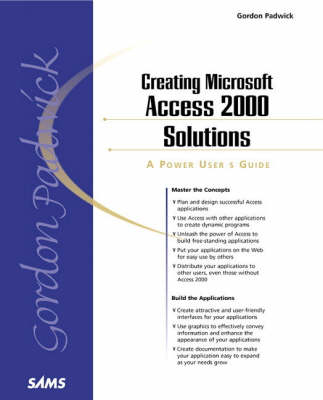
Creating Microsoft Access 2000 Solutions
Sams Publishing (Verlag)
978-0-672-31894-8 (ISBN)
- Titel ist leider vergriffen;
keine Neuauflage - Artikel merken
PLEASE PROVIDE
From within Access, users can easily build simple customized applications. Rather than hire a developer, they can create simple applications on their own. Creating Access 2000 Applications shows them how. This book builds upon your knowledge and understanding of Access, teaching you the fundamentals of application design, how to create fully functioning applications with menus, forms, toolbars, and how to use tools and features of Office 2000 in application development. You'll also learn how to generate dynamic reports and interactive applications for the Web.
Gordon Padwick is a consultant who specializes in Microsoft Office applications and Visual Basic. In addition to training and supporting Office users, Gordon develops custom applications based on the Office suite. He has authored a number of Macmillan titles including Programming Microsoft Outlook 2000, Building Integrated Office Applications, Special Edition Using Microsoft Office 97 Professional, Special Edition Using Microsoft Outlook 97 and Special Edition Using Microsoft Outlook 2000.
Introduction.
Who Should Read This Book. How This Book Is Organized. Web Site References. Author's Final Comment.
I: PLANNING AND APPLICATION DESIGN.
1. Planning Successful Access Applications.
Understanding the Importance of Planning. Aspects of Planning an Access Application. Taking Advantage of What's New in Access 2000. Documenting Your Application. Summary.
2. The Anatomy of an Access Application.
Understanding Access's Object Structure. The Database Window. Tables. Queries. Forms and Reports. Data Access Pages. Macros. Modules. Database Engines. Working with the Book Application. Summary.
3. Storing Your Data Efficiently.
Understanding the Importance of Organizing Your Data Tables. Creating Fields That Suit Your Requirements. Setting Field Properties. Making Your Intentions Clear by Including Field Descriptions. Indexing Tables to Speed Up Your Application. Managing Relationships Between Tables. Printing a Report of Relationships. Entering Data into Tables. Displaying Data in Datasheets and Subdatasheets. Summary.
4. Creating Information Out of Data.
Manipulating Data in Tables. Using Select Queries to Organize Data. Understanding the SQL View of a Query. Making Your Queries Run Faster. Using Parameter Queries. Analyzing Numeric Information. Joining Tables and Queries. Using Advanced Filter/Sort. Summary.
II: USING FORMS TO ENTER AND DISPLAY DATA.
5. Making Your Forms Smarter.
Displaying a Form Automatically. Creating a Switchboard Form. Displaying a Splash Screen While Access Starts. Creating a Form Based on a Table or Query. Summary.
6. Making Data Input Fast and Accurate.
Making Automatic Entries in Tables. Making Choices on a Form. Validating Input Data. Validating a Table Field. Validating an Identification Code. Formatting Your Data in Forms and Reports. Setting Input Mask Properties for Controls on a Form. Automatically Updating Data. Keeping Users Informed. Summary.
7. Enhancing Your Application with Pictures and Other Graphics.
Using Lines and Boxes as Design Elements. Incorporating a Logo To Give Forms and Reports an Identity. Using a Form or Report to Display Pictures from Records. Summary.
III: FINDING AND PRINTING INFORMATION.
8. Creating Informative Reports.
Understanding Access Reporting. Creating a Report. Enhancing Reports with Graphics. Combining Reports. Improving Report Performance. Summary.
9. Finding Records in a Database.
Displaying Records Consecutively on a Form. Displaying a Record That Contains Specific Information. Summary.
IV: ACCESSING EXTERNAL DATA AND APPLICATIONS.
10. Using External Data in an Access Application.
Choosing a Database Configuration. Linking and Importing Data. Exporting Data from an Access Application. Summary.
11. Using Object Models Within the Office Environment.
Understanding Objects and Object Models. Working Within a Single Access Application. Extending the Scope of Access. Summary.
12. Accessing Data.
Putting Data Access into Perspective. Understanding ActiveX Data Objects. Accessing Data in the Native Access Format. What You Need to Know About Variables. Displaying Information from a Recordset. Using Data Access Objects Instead of ActiveX Data Objects. Summary.
V: GETTING MORE OUT OF ACCESS.
13. Taking More Control of Access.
Understanding Macros in Access. Responding to Form and Report Events. Writing VBA Code Within Event Procedures. Using Custom Procedures. Responding to Runtime Errors. Optimizing an Access Application. Summary.
14. Making Access Applications Easy to Use.
Providing ScreenTips and ControlTips on Your Forms. Customizing Menus and Toolbars. Creating Command Bars and Command Bar Objects. Securing Your Customized Toolbars and Menus. Summary.
15. Calculating Values and Making Decisions.
Understanding Operators. Using Operators in Queries. Using Operators in Filters. Controlling the Flow of a Macro. Using Operators in VBA Code. Summary.
16. Maintaining a Healthy Application.
Compacting and Repairing a Database. Cleaning Up Your Application. Backing Up Your Application. Archiving Your Data. Summary.
17. Extending Access to the Web.
Using Hyperlink Fields. Exporting to a Web Page. Introducing Data Access Pages. Summary.
18. Making Your Application Secure.
Protecting a Database File with a Password. Establishing Yourself as a Database Administrator. Controlling Access to Data with Groups. Assigning Permissions. Summary.
19. Increasing the Capabilities of an Access Application.
Installing the Microsoft Data Engine. Running a Sample MSDE Project. Upsizing and Downsizing Applications. Summary.
20. Sharing an Application with Other People.
Sharing an Access Application on a Network. Sharing Access Applications with People Who Don't Have Access Installed. Summary.
Appendix A. Visual Basic for Applications Primer.
Setting Up Your VBA Laboratory. Getting Help for VBA. Understanding VBA Modules. Understanding VBA Structure. Understanding Functions. Expressions. Controlling Program Flow. Making Your VBA Code Easy to Understand.
Appendix B. SQL Primer.
SQL Statements for Select Queries. SQL Statements for Action Queries. SQL Statements for Union Queries.
Appendix C. Information Resources for Access 2000.
Books. The World Wide Web and Periodicals. Newsgroups.
Glossary.
Index.
| Erscheint lt. Verlag | 1.6.2000 |
|---|---|
| Verlagsort | Indianapolis |
| Sprache | englisch |
| Maße | 187 x 232 mm |
| Gewicht | 964 g |
| Themenwelt | Mathematik / Informatik ► Informatik ► Datenbanken |
| Informatik ► Office Programme ► Access | |
| ISBN-10 | 0-672-31894-6 / 0672318946 |
| ISBN-13 | 978-0-672-31894-8 / 9780672318948 |
| Zustand | Neuware |
| Informationen gemäß Produktsicherheitsverordnung (GPSR) | |
| Haben Sie eine Frage zum Produkt? |
aus dem Bereich


